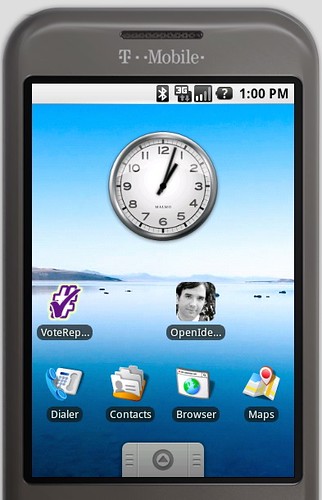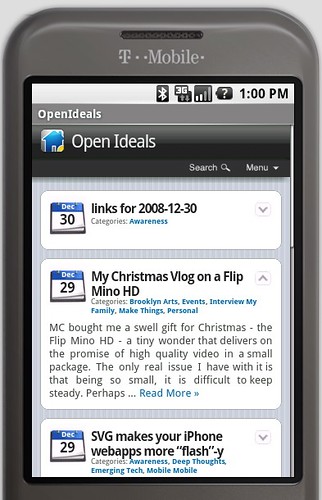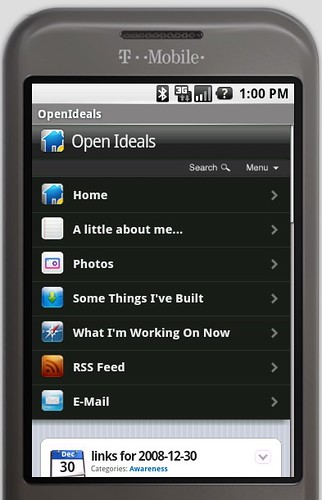-
This Innocell extended battery provides up to 15% more capacity in the same size package. It is a great replacement with more power than the original.
-
It is an easy to embed service that will take care of delivery, anti-blacklisting and antispam for any business.
links for 2009-01-02
-
PlotKit is a Chart and Graph Plotting Library for Javascript. It has support for HTML Canvas and also SVG via Adobe SVG Viewer and native browser support.
-
The simplest kind of animation that we’ve added support for is called a transition. Normally when the value of a CSS property changes, the rendered result is instantly updated, with the element in question changing immediately from the old property value to the new property value. Transitions describe how to instead execute an animation from the old state to the new state over time.
WTF: Why I Built My "Blog App" for Android
A few weeks ago I wrote post demonstrating how to turn your blog into an iPhone App with a few easy steps, using the Phonegap approach, along with Apple’s Dashcode development tools.
Today I am happy to announce that I’ve used the same approach to develop and release an app for the Android platform, which you can download today on your T-Mobile G1. Just search for “nathan” or “open ideals” in the Android Market.
Now, as always, there are plenty of haters in the market comments for my app, most people having no idea why some dude is “shamelessly promoting” himself or calling the app “spam”. To be honest, I don’t really want or expect random people to download my app… I just want it there so I can demonstrate the possibilities of linking together a few cool pieces of tech to build a rich mobile application….
I agree that my personal blog may not have much use for the average G1 user, but imagine the possibilities… perhaps in a more functional application, you could integrate a WebView component into it, that points to a mobile-enabled user support blog. Maybe you want to create a blog that can react to a users geographic location… use phonegap to submit the GPS coordinates to your wordpress system, and present the relevant posts. Instead of thinking about this is as a “blog app”, think of it as a quick launch into a searchable, dynamic content platform… plenty of interesting applications for that architecture!
Quick Rundown of the Tools Used
1) Phonegap – a native wrapper for the webkit browser on the iPhone and Android platforms… basically allows you to build webapps, but distribute them as native code through the App Store and Android Market. Learn more at phonegap.com
2) WordPress – a great, simple CMS that has support through themes and plugins for rendering in a mobile friendly format. I used the WPtouch theme for WordPress, which makes any WP install look fantastic on iPhones, iPod Touches and of course Android.
3) Eclipse – You pull all the code together using the Android SDK with the Eclipse IDE. What’s great about this is that Eclipse allows you to develop both your Android app and your Web app side-by-side… so you can hack your web code, customize your mobile themes, etc, all while glueing together your phonegap app. It is a great seamless experience, and a perfect way for a web developer to transition into being a “mobile app” developer.
Here’s some screenshots of the blog app in action…
links for 2008-12-30
-
The second in the MobileActive barcamp series, we'll explore mobile tech to advance social development and social change goals. Expect this to be highly participatory and interactive, and cover anything you wanted to know about using mobiles for social change. MobileTech for Social Change New York is open to anyone with passion and interest in the topic and since it's a barcamp, bring your ideas, innovations, products, tools, projects, and organizations!
My Christmas Vlog on a Flip Mino HD
MC bought me a swell gift for Christmas – the Flip Mino HD – a tiny wonder that delivers on the promise of high quality video in a small package. The only real issue I have with it is that being so small, it is difficult to keep steady. Perhaps with time and practice I’ll improve. However, the upside of the stealth profile is that almost no one notices I am filming them at all, allowing me to capture people in very natural moments. Also, according to my buddy noneck, you can hack your flip, adding a wide angle lens to it!
Anyhow, enjoy this four minute peek into my Christmas day revelry….
Christmas in the Colonies from natdefreitas on Vimeo.
This was definitely the year of gadgets for me, as I also was given a Polaroid Pogo mobile printer and a ThinkGeek Wifi Finder T-Shirt! More on these awesome toys in a later post…
Many thanks to Snr. Sufjan Stevens for the tune… go buy his Christmas album if you like it!



